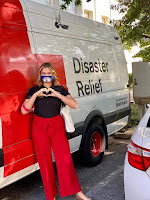By Jake Verga, Communications Volunteer
_______________________________________________________________________
“It is an honor to work side-by-side with service members whose kind and caring manner creates a positive atmosphere. I observe people genuinely happy and relieved when leaving the clinic. That tells the story of a job well done. 'Hope remains eternal' is my message. I feel it each time I arrive at Walter Reed National Military Medical Center.”
- Marianne Wyble, Red Cross Volunteer, Walter Reed
_________________________________________________________________________
On March 11th, 2020, the World Health Organization labeled COVID-19 as a global pandemic. And just two days later, the President of the United States declared that very pandemic a national emergency.
Now, a full year after COVID-19 swept across America, with a nationwide vaccination effort underway and case numbers beginning to grow smaller, things seem to be getting better. But a lot has happened since last March.
COVID-19 has had far-reaching effects on almost every aspect of life, from education to grocery shopping. But periods of hardship help highlight the empathy and perseverance that make the human experience unique and special. Nothing exemplifies this more than those volunteering in the National Capital & Greater Chesapeake Region, who over the past year have dedicated their time helping those who need it most.
One of the most active volunteer locations for the Red Cross during the pandemic has been Walter Reed National Military Medical Center. Walter Reed’s Senior Station Manager, Kristen Farren, who helps coordinate volunteers, spoke about what they have been doing to make a difference.
In conjunction with medical center staff, volunteers have been on-site, working to provide cloth masks to patients and visitors to the hospital. Over the course of many months, thousands of masks were brought in and distributed to those who needed them. Kristen couldn’t stress enough how the volunteers and administrators at the Red Cross are extremely grateful for those who went out of their way to donate. On top of help with the masks, volunteers helped sanitize essential items such as clipboards and pens, making the visitation process safer.
 |
| The Daughters of the American Revolution generously donated cloth face coverings to the Walter Reed team in the spring of 2020. |
As well as mask distribution, the Red Cross also partnered with a nonprofit organization called Feed the Fight. Feed the Fight is based in the D.C. Metro Area and began as a neighborhood effort that ended up growing into a multi-state network of volunteers. The organization works to both help patronize local restaurants, while also helping support front-line workers. Using monetary donations, the organization purchases meals from local restaurants and then donates these meals to healthcare workers who are fighting the pandemic every day. The Red Cross helped organize and distribute these meals in March, April, and May, when the country was experiencing its most tumultuous period as the virus was rapidly spreading. These meals made the staff feel very appreciated.
 |
| The Walter Reed team delivered lunches from Mission BBQ and Jetties to the staff thanks to Feed the Fight during the pandemic. |
 |
| Red Cross volunteers, Janice (left) and Mindy, on location at the COVID vaccination site helping to sanitize and distribute clipboards and paperwork. |
_______________________________________________________________________
“Many of the patients were totally unaware of the opportunity to get a vaccination and required a lot of time to explain exactly what they needed to do. Some of the patients were in their 90s and a couple over 100. And, they were so appreciative. Each call made my day and I was eager to dial the next.”
- Stephen Peth, Red Cross Group Leader and Walter Reed Volunteer
_________________________________________________________________________
- To learn more about the Service to the Armed Forces programs, click here.
- Make a difference in your community. Click here to become a Red Cross volunteer.
- To make a donation to your Red Cross, click here.
- Click here to learn more about donating blood with the American Red Cross near you.
































